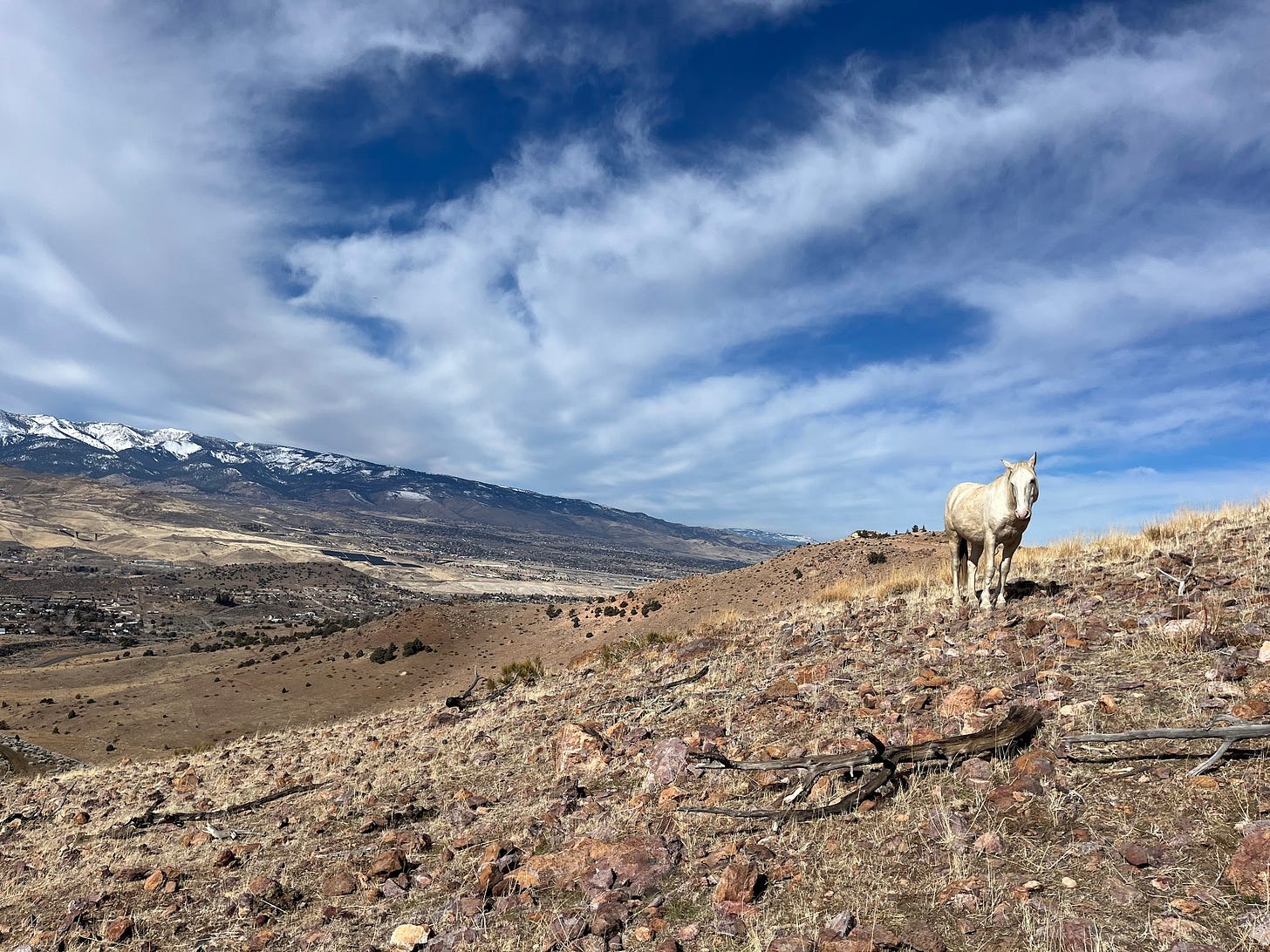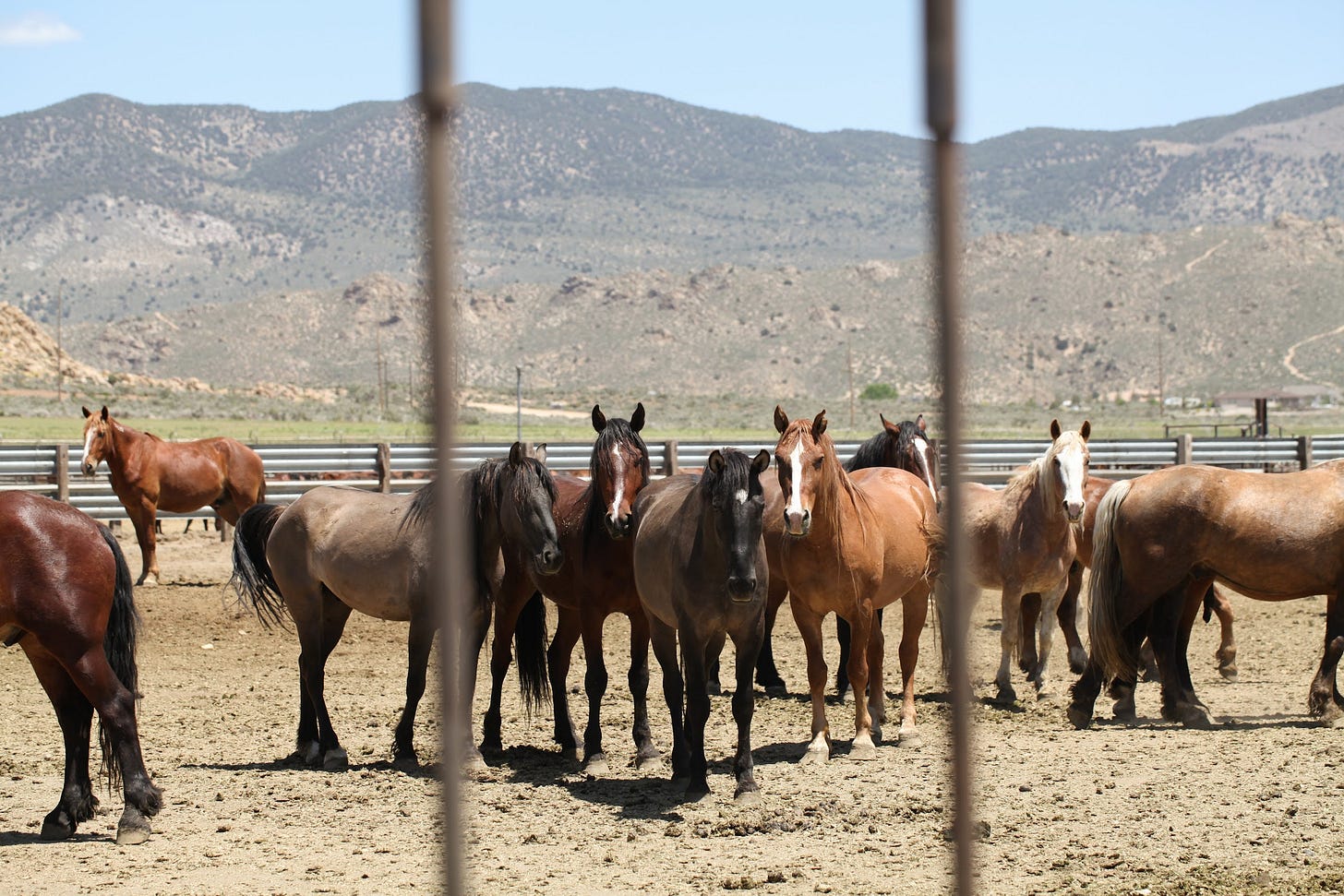In Conversation With: Julia Juster (Part I)
"Every time I’m in Nevada, every person I meet, every day I spend on the range or in the archives, confirms that [the wild horse] issue is as vast as its landscape."
Back in March, Julia sent me an email that started with “I’m writing a book about wild horse management and I’m getting married in August”—which pretty much guaranteed an immediate reply. We got on a zoom and chatted everything from rats to her deep-rooted need to understand feelings that fuels her as a writer, and in this case, very much an investigative journalist. We ended up collaborating on an stunning custom silk bandana for her wedding next month (yes there will be pictures!) but the more curious part of her introduction, as you might have imagined, was this book about wild horse management.
As an Instagram spectator, I am by no means an expert—but even a quick peek into the comments section of a post by any number of wild horse rescues working in the West will give you an indication of just how passionate people are about this topic. As a kid, I loved the books Wild Horse Annie and Misty of Chincotegue, stories of brave protagonists and the wild horses they loved and fought for. Following the BLM roundups of wild horses in Nevada on social media, you can’t help but feel motivated to want to fight for the rights of these animals who have no mouthpiece besides those that have taken up their cause.
But the issue is much, much more complicated than merely reuniting a stallion with his captured herd or a lost foal with its mother. For Julia, the moment a friend sent her the catalog for the wild horse auction at the Northern Nevada Correctional Center, she was transfixed, and for the last three years has jumped head-first into investigating the intricacies of managing the tens of thousands of wild horses and burros across several Western states, a task assigned to a federal agency that oversees a total of about 245 million acres across US territories using federal tax dollars, the Bureau of Land Management (BLM).
This is Part I of a two-part series.
Cece Liu: Tell us a bit about how you fell for horses—have you always been a horse girl?
Julia Juster: Not publicly! I know horse girls are in vogue at the moment (literally), but in middle school I got the sense that being the kid who would rather hang out with an eight-hundred-pound herbivore than anyone her own size—or species—wasn’t exactly something to brag about [insert horsegirl meme here]. I took lessons once a week for a few years, I went to rodeo camp in Wyoming during the summers, I read as much of the Heartland series as I could without buying it from Borders…but the horse girl was pretty much dormant by the time I went to high school.
Horse girl wasn’t always a trend—or an insult! Not when horses were everywhere. The relationship between horses and humans completely changed the trajectory of civilizations: languages spread, new technologies developed, and war was transformed. For more centuries than not, horses were anything but niche. They were everywhere, they were necessary, and they were powerful tools in conquest, colonization, and industrial revolution. But that’s not really an argument I had when I was 12, so I couldn’t use it to explain why I wanted my mom to drive me to the barn all the time. And even though I find the history fascinating, I still don’t think it explains why I’m so interested in this animal! Do any of us have a “reason” at the core of what we love? And why people love horses is never as interesting to me as how they love horses. The book is about the contradictions within that love, what a relationship with this animal can create—and distort.
(Okay, if I had to say, I really love the shape of their ears.)
CL: What first sparked your interest in the topic of mustangs and land management, and then the idea of possibly doing a book?
JJ: I guess horse girls can’t hide. A friend of mine clocked me right away. She sent me the catalog for the wild horse auction at the Northern Nevada Correctional Center. I knew there were still free-roaming horses in the American West, but I had no idea that incarcerated people were training them and putting them up for adoption. I was shocked—it was the most American shit I’d ever seen. Cowboys and the carceral state? How did we get here? The same friend told me to bid on one of the horses, but I was nowhere near ready for that. She said if I was going to be a wimp, the very least I could do was write about it. She’s a great friend.
That was three years ago. Every time I’m in Nevada, every person I meet, every day I spend on the range or in the archives, confirms that this issue is as vast as its landscape. And understanding it takes time. Building relationships, observing ecosystems, tracking politics—these aren’t quick processes. A book makes space for my own understanding to evolve, and it keeps me from simplifying the kinds of tensions that are central to the questions I’m asking about independence, wildness, and stewardship.
CL: What has opening up this exploration led to? What experiences have you sought out in your research to further investigate?
JJ: Even with the best intentions, I know the human mind is wired to make short cuts. It’s too easy to be tempted toward reduction, especially when a topic is divisive and emotionally charged. So I try not to write about someone or something I’ve only encountered once. That means being with people and in places multiple times, researching topics from multiple angles, and following the horses as far as I can. I’ve attended the wild horse auction at the prison four times now! In between, I’ve observed a helicopter round up at dawn, hiked into the hills with fertility control teams, cleaned stalls at a horse sanctuary, and driven to Nevada and back more times than I can count. I’ve interviewed government officials, advocates, ecologists, lobbyists, lawyers, and horse lovers of all politics and persuasions. I’ve studied up on rangeland science, the history of barbed wire, evolution, poetry, and the inner workings of a congressional committee. It all leads back to the horses!
CL: The idea of “use of public lands” and those public lands being managed by a government entity meant to represent the public interest seems ripe for influence by different interest groups in the name of "balance." Have you been exploring this in your research as well?
JJ: Absolutely. The wild horse question is a public land question, and the public land question is an urgent one, especially now that the potential sale of that land has been introduced into the most recent Senate bill, challenging tribal sovereignty and threatening already vulnerable ecosystems.
More than one fourth of all land in the United States is public. Most of that land is concentrated in the American West and includes our most iconic national parks, monuments, and wildlife areas. Public land belongs to the people and is managed on their behalf by the government. This management is split between a number of different agencies representing various interests, including conservation, energy, agriculture, and defense. Public land is, by law, multi-use. It cannot be restricted to just one venture or priority, which both protects it from being monopolized by a particular sector, and presents challenges in management. Horses and burros share federal land with livestock, mining operations, and conservation efforts—to name a few. This means management and protection efforts either collaborate or conflict with other powerful, passionate interest groups.
CL: Can you paint us a picture of what the current wild horse management situation looks like?
JJ: Before we get into them, it’s important to say the horse numbers are complicated and contentious. Not only is it challenging to get an accurate count of this many animals across this much land, but the target population numbers are often contested by groups who question competing motives for bringing the number of horses and burros down. Still, no matter the numbers, people on all sides of the issue are concerned. Government representatives and scientists often point to damaged landscapes, other vulnerable species, and herds of horses struggling to survive. Advocate groups point to mismanagement and exceptions made for cattle and mining industries. No one I’ve talked to believes the situation is sustainable as is.
Today, more than 73,000 horses and burros roam public land across Arizona, California, Colorado, Idaho, Montana, Nevada, New Mexico, Oregon, Utah and Wyoming. That 73,000 does not include free roaming horses and burros also on state and tribal land. In 2024, the Navajo Nation Department of Agriculture estimated an additional 100,000 horses roaming Naabeehó Bináhásdzo. Meanwhile, the number of horses and burros the Bureau of Land Management (BLM) estimates these lands can sustain is about 25,000.
A healthy horse consumes at least fifteen pounds of forage a day, and drinks ten gallons of water. That’s the kind of diet that can only be sustained with the support of humans or on healthy grasslands. The American West is entering its 25th year of megadrought. There are more than 40,000 free-roaming horses in Nevada alone, and Nevada is the driest state in the union. Meanwhile, as we debate the wild horse issue, more vulnerable and less popular species suffer, and the land is additionally impacted by mining, grazing, and development.
And then there’s the money. The 73,000 horses roaming federal land in those ten states are managed by the Bureau of Land Management (BLM). The 1971 Wild and Free Roaming Horses and Burros Act of 1971 made it illegal to hunt, slaughter, or export these animals. Currently, the BLM relies on controversial roundups and sporadic fertility control treatments to manage herd sizes. Horses and burros taken off the range are placed in long term holding facilities, and the majority of the Wild Horse and Burro budget goes to feeding and caring for those animals for the rest of their lives. There are 64,000 horses and burros in long term holding. It costs about $2 per animal per day, or at least $46 million in taxpayer dollars per year. Most horses and burros live to be over twenty years old, and so most of the budget allocated to the Wild Horse and Burro Program (at least two thirds of it) goes to caring for those horses in holding. That leaves less money for removal efforts or alternative management strategies, like fertility control. Meanwhile, fewer than 5% of horses and burros are adopted out of holding each year. That’s not for lack of interest or care from the public; it’s a numbers issue. Despite sanctuaries and adoption programs across the country, there simply aren’t enough people in the United States with the time, money, or expertise to care for these horses.
In Part II we continue our conversation on the complexities of wild horse management, but also delve into our own obsession with the idea of the mustang versus the reality of the animal in the real world. It’s a truly fascinating discussion—we could have gone on for hours!
More next week…










This is an incredibly complex topic, with various, powerful interests each believing their own truth. Eager for Part II. Skillful questioning! Thank you!
Thanks so much for chatting (and silk scheming) with me!